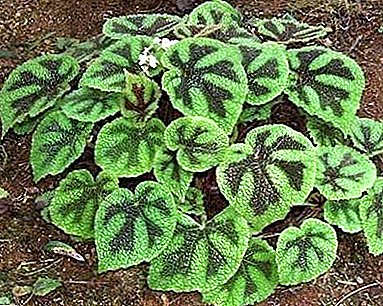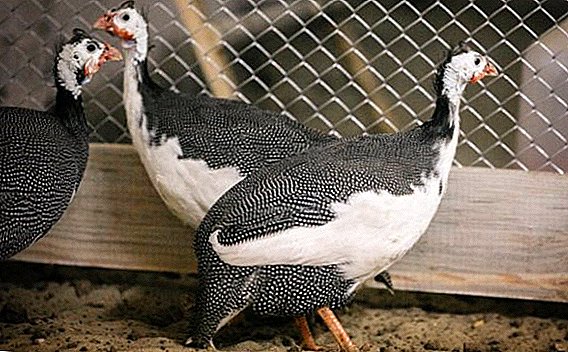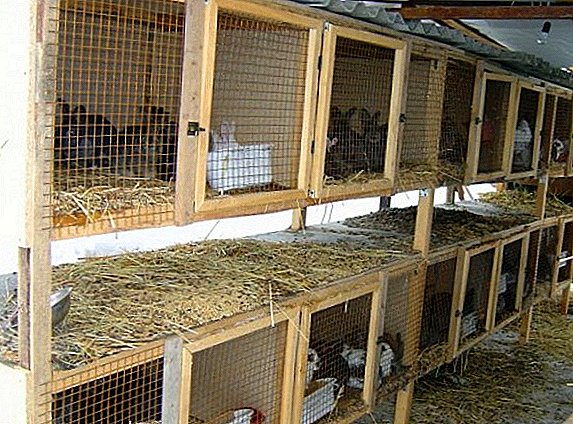 From time to time in domestic rabbits, hair begins to fall out intensively, and even completely naked skin is formed. This phenomenon can be caused by both natural causes and testify to various diseases or external adverse factors. Consideration of these causes and factors is devoted to this material.
From time to time in domestic rabbits, hair begins to fall out intensively, and even completely naked skin is formed. This phenomenon can be caused by both natural causes and testify to various diseases or external adverse factors. Consideration of these causes and factors is devoted to this material.
Age and seasonal moulting in rabbits
This process occurs regularly, usually 2-3 times a year or more. The coat may fall out quite intensively, on the rabbit skin often bald areas are formed. To interfere with this process is meaningless - a new hair grows very quickly.
When molting, part of the falling out hair usually enters the animal's stomach. If it accumulates there too much, it will lead to serious problems with the work of the animal's intestines.
To avoid such a problem, rabbits are combed out during the molting period, thus reducing the amount of wool that can get into their stomachs. In addition, at the time of molting increase the proportion of hay and straw in the diet of animals - these products contribute to the removal of swallowed wool from the intestine.
Important! A sign that the rabbit's intestinal function is disturbed due to too much swallowed wool is a sharp decrease in the amount of feces secreted by it. In this case, it is recommended to give the animal 5-10 ml of vaseline oil. If the defecation stops completely and the animal is in a depressed state, then the vet must examine it.
Various diseases
In addition to molting, hair loss may be a symptom of a disease or the result of parasite activity. Consider these and other reasons for the formation of bald patches on the animal's skin.
Fleas
Very often rabbits become infected with fleas from dogs and cats. If the animal is affected by these parasites for a long time, then he may develop an allergy, accompanied by hair loss.
In addition, fleas are carriers of myxomatosis, a very dangerous viral disease.  To get rid of fleas, use various means, for example, drops "Frontline", "Advantage", the drug "Neguvon" or special shampoos. All these tools are used according to the instructions for their use.
To get rid of fleas, use various means, for example, drops "Frontline", "Advantage", the drug "Neguvon" or special shampoos. All these tools are used according to the instructions for their use.
We advise you to read about how to properly remove fleas from rabbits.
Pliers
Rabbits infect different types of ticks, namely:
- Fur tick (Cheyletiella) at first it usually affects the area around the tail, then spreads further. His long-term livelihoods cause severe hair loss, the remaining falls into clumps, there is reddening of the skin and itching. The disease caused by this parasite is called cheilioziosis.

- Ear Tick (Psoroptes) causes psoroptosis. At the initial stage, it affects the ears, which eventually form a gray crust. Due to the gradually increasing itch, the animal actively scratches its ears. Over time, the parasite damages the eardrums, which can lead to meningitis and death.
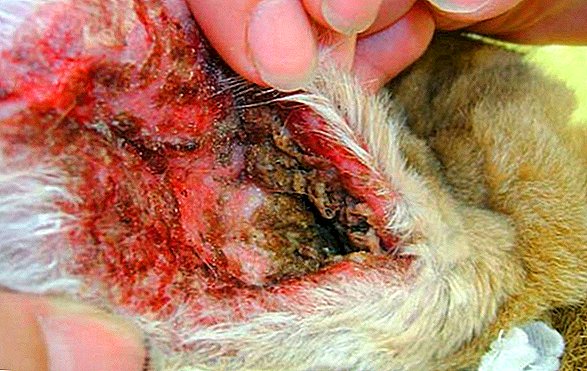
- Subcutaneous, it is a scab mite (Sarcoptes) is the cause of sarcoptosis. This type of parasite initially settles near the nose, eyes and the base of the ears, then spreads to other parts of the body. It causes severe itching, the animal scratches the affected places, there are boils and fur falls there, the animal loses its appetite, there comes a general depletion. Often when combing in the rabbit body infection is entered.
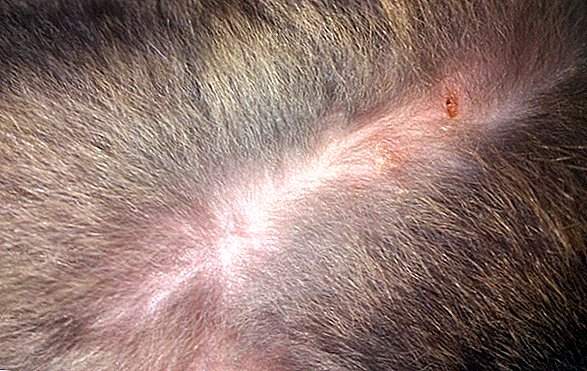
Did you know? The longest-eared rabbit in the world is the representative of the English lop-eared breed named Nipper's Geronimo living in the USA. The distance from the tip of one ear to the tip of the other was 79 cm.
Ringworm (skin fungus)
Under this name are combined diseases of trichophytosis, microsporia and scab (favus) caused by skin fungi Trichophyton, Microsporum and Epidermophyton. Trichophytosis and microsporia are popularly referred to as "ringworm." Symptoms in varieties of ringworm are somewhat different.
Externally, trichophytosis and microsporia appear as the formation of spots on the rabbit skin that are hairless (hairs during trichophytia break off at the roots) and covered with grayish-white scales, scabs, purulent nodules, dried lymph.
They can cause itching, in which case the animals comb them. When scab on the body appear small, the size of a pea-shaped, covered with a crust. With the separation of the peel visible hollow. The adjacent formations merge.  The death of rabbits with ringworms is very rare, but these diseases inhibit the development of young animals, reduce the immunity of animals, cause them suffering. The appearance of diseased animals is significantly deteriorating.
The death of rabbits with ringworms is very rare, but these diseases inhibit the development of young animals, reduce the immunity of animals, cause them suffering. The appearance of diseased animals is significantly deteriorating.
For the treatment of ringworms use remedies for both external and internal use. This could be, for example, the antifungal antibiotic "Griseofulfin", the ointment "Saprosan" or "Unisan", the drugs "Ketoconazole" or "Miconazole."
The type and dosage of the drug is determined by the veterinarian. The drugs used to treat ringworm in humans are unsuitable for rabbits, since animals can lick ointment-treated skin and thus become poisoned.
It will be helpful for you to read about how to water the rabbits, what they eat and how to feed the rabbits in winter, what to not feed the rabbits, what grass to feed the rabbits, and whether rabbits eat nettle, nettle and burdock.
The cage in which the infected animals were kept is necessarily disinfected, otherwise the rabbits can get sick again, since the fungi in the external environment retain their viability for up to a year.
Spirochetosis (rabbit syphilis)
It is an infectious disease whose pathogen is treponema (Treponema). At the initial stage, the redness and swelling of the genital organs, as well as the anus of the animal, are observed, and hair loss begins later.  Spirochetosis is a multi-stage treatment, it is prescribed by a veterinarian. Erythromycin, Novarsenol solution, bismuth salicylate emulsion, and Bicillin are usually prescribed.
Spirochetosis is a multi-stage treatment, it is prescribed by a veterinarian. Erythromycin, Novarsenol solution, bismuth salicylate emulsion, and Bicillin are usually prescribed.
Urinary dermatitis
This disease is the result of inadequate care for rabbits, due to which the skin of an animal is too often in contact with urine and feces. Especially long-haired breeds suffer from this. Initially, dermatitis is observed around the genitals and anus, but it quickly spreads to the abdomen.
We recommend to get acquainted with the best meat, decorative, fur and down rabbit breeds.
Wool falls on the affected areas, they emit an unpleasant odor. To solve this problem, first gently pull out the remains of wool on problem areas. Then the animal is washed with baby soap, change the litter. To relieve inflammation using the gel "Aloe Vera" or the like.
It is also recommended to examine the animal at the veterinarian, as the cause of dermatitis may be too frequent urination of the animal, caused by the formation of clots in the bladder. In this case, a bladder wash or an injection "Valium" is prescribed. 
Avitaminosis
Youngsters are particularly susceptible to this disease. It may develop due to poor feeding and unsanitary conditions. In addition to other symptoms (conjunctivitis, rickets, decreased activity, etc.), hair loss may also occur.
The problem is solved with vitamin supplements (Chiktonik, Rex Vital, Ushastik), the introduction of fish oil, fresh greens, hay, conifers and fruit trees into the diet.
Did you know? It is assumed that in ancient times the Phoenicians, mistakenly mistaking the Iberia rabbits for damans common in the Middle East (these are small herbivorous mammals), called the newly discovered area I-Shaphan-im, which means "Daman's coast". Subsequently, this name was transformed throughout the well-known "Spain".
Hormonal imbalance
Such a diagnosis is made solely on the results of an animal blood test. The cause of the disease can be a prolonged lack of vitamins K, E, as well as selenium. Treatment prescribed by a veterinarian. Hormone preparations that normalize hormone production can be prescribed, as well as the diet of the animal. 
Swelling and swelling on the body
Such formations can be a cyst (pathological cavity in the tissues), an abscess (purulent inflammation of the tissues), a benign or malignant tumor, an old scar.
If a new swelling is found, it is recommended that the pet be examined by a veterinarian. According to the results of the examination, treatment can be prescribed, up to a surgical intervention.
Nervous disorders
Often, rabbits very nervously react to the flash, the presence of strangers, unfamiliar surroundings, loud noises or constant noise, vaccination. Stressful situation provokes intensive hair loss, up to balding large areas of the skin.
Find out if you can keep chickens and rabbits together.
In addition, sometimes you can see how animals literally devour the wool from one another or even from one another. This is explained by the same nervous situation that develops due to the crowded content of animals.
There is also a version that rabbits eat each other because of boredom. It is not known how this is true, but in animals that are kept not too crowded and periodically walking, such phenomena are usually not observed. 
Other possible causes of baldness
In addition to disease, hair loss or lack of it from birth can be caused by other reasons, such as heredity, the body's allergic reaction to injection, and even be the result of fights between males.
Genetics
Congenital alopecia most often affects ornamental breeds. Animals born with such a deficiency either do not live up to one month of age and die, or live normally, and their wool can begin to grow several months after birth.
Get acquainted with the diseases of rabbits, methods of their treatment and prevention.
Genetic abnormalities can not be cured in any way, one can only hope that the little rabbit born without hair will not die and will eventually acquire hair.
Reaction to drug injection
Sometimes around the site where the rabbit was injected, hair starts to fall out. This may be due to an improperly injected injection or an allergic reaction of the animal to the injected drug.  Usually, this complication goes away by itself, but suppuration sometimes occurs. In this case, you may need the help of a veterinarian - he will clean the wound from pus.
Usually, this complication goes away by itself, but suppuration sometimes occurs. In this case, you may need the help of a veterinarian - he will clean the wound from pus.
Important! To reduce the risk of complications after injections, it is necessary to follow simple rules: change the needle after each injection to the animal and cut off the hair at the injection site, and treat the clipped area before injection with alcohol or iodine.
Fights (rabbit battles)
This situation is not uncommon, and fights occur both between males and between females. During the fights, the animals are capable of inflicting serious injury to each other. Usually, this phenomenon is fought by precipitating the most aggressive individuals into separate cells. Some rabbit breeders practice castration of males, but this measure in some cases does not help immediately - the animal can remain aggressive for a long time.
So, the reasons why rabbits lose hair, there are a great many. There are universal measures, the adoption of which will seriously reduce the risk of baldness of animals. These are disease prevention, balanced nutrition, good housing conditions, as well as the protection of animals from stressful situations.








